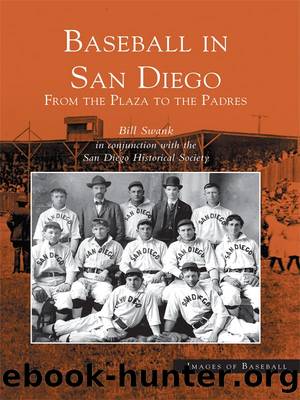Baseball in San Diego by Bill Swank

Author:Bill Swank
Language: eng
Format: epub
Publisher: Arcadia Publishing Inc.
Published: 2011-09-01T00:00:00+00:00
Before the start of the Coast League season, the Portland Beavers scheduled a five-game series with the American Giants. Rube Fosterâs team won four of those five games. âMcCredie [Beavers manager Walter âJudgeâ McCreedie] concedes that several of the dusky men are of major league caliber and that only the drawing of the color line forces them out of organized baseball.â How good was Portland? That year the Beavers would go on to win the Pacific Coast League championship.
Nineteen Thirteen was a watershed year for baseball in San Diego. The Southern California Class D League formed and San Diego got one of the teams. The owner was former major league veteran Duff âDickâ Cooley, who had received early retirement in 1906 when he was replaced in the Detroit outfield by a flash named Ty Cobb. Subsequently, Cooley had experience operating successful minor league teams in Topeka and Salt Lake City. He sold his interest in the Salt Lake club to partner Bill âHardrockâ Lane in 1912 and used the money to purchase the San Diego franchise.
On April 22, 1913, a grand Opening Day automobile parade was delayed temporarily because Mr. Cooley had failed to obtain the proper permits. An hour late at Athletic Park, the ceremonial first pitch was more-or-less tossed by Mayor-elect Charles F. OâNeall. The totally new and mighty San Diego Bears took the field in their navy blue uniforms. They dropped a heartbreaker to the Pasadena Millionaires, 4-2. Regardless, the fans were âthrilled by snappy ballâ and the confident Cooley assured the multitude, âWe will get after them strong tomorrow.â
Dick Cooley was absolutely correct. San Diego won the next day, the next day after that, and day after day following. A week later, the Bears were pulling away from the league with a 9-1 record. An unexpected problem occurred when Pasadena ministers strongly protested playing baseball on the Sabbath. The equally pious clergy of Long Beach, âwhich has the most drastic anti-liquor ordinance in the state,â also vehemently opposed Sunday baseball. Major scheduling changes were made to avoid further hell and brimstone from the pulpit.
By the end of May, the 29-8 Bears were lapping the field. The âpure cities,â Pasadena and Long Beach, were struggling along at 11-26 and 12-25, respectively. Attendance was dwindling throughout the circuit. Bears manager Spencer Abbott was sent to Pasadena in an effort to save a team that would eventually seek redemption in Santa Barbara.
Cooley sold brilliant young shortstop Charles Flanagan to the St. Louis Browns for the princely sum of $3,500. Sailor Flanagan had only been able to play home games pending his discharge from the Navy on June 27. Two days later, the ingrate demanded $500 of the sale price. Cooley refused to consider this outrageous request. Charlie Flanagan learned quickly that it was as difficult to hit a major league curve ball as it was to separate âa handful of C notesâ from a base ball owner. The surly sailor disappeared into obscurity after three hitless plate appearances for the lowly 1913 American Leaguers.
Download
This site does not store any files on its server. We only index and link to content provided by other sites. Please contact the content providers to delete copyright contents if any and email us, we'll remove relevant links or contents immediately.
Machine Learning at Scale with H2O by Gregory Keys | David Whiting(3640)
Never by Ken Follett(3532)
Liar's Poker by Michael Lewis(3228)
The Ultimate Backcountry Survival Manual by Aram Von Benedikt; Editors of Outdoor Life;(3172)
Will by Will Smith(2581)
The Partner by John Grisham(2286)
Can't Hurt Me: Master Your Mind and Defy the Odds - Clean Edition by David Goggins(2004)
Friends, Lovers, and the Big Terrible Thing by Matthew Perry(1998)
Taste by Kris Bryant(1802)
HBR's 10 Must Reads 2022 by Harvard Business Review(1698)
A Short History of War by Jeremy Black(1671)
Never Finished: Unshackle Your Mind and Win the War Within by David Goggins(1558)
The Arm by Jeff Passan(1522)
515945210 by Unknown(1521)
The Dodgers by Schiavone Michael;(1477)
The Yogi Book by Yogi Berra(1426)
443319537 by Unknown(1395)
1942266391 (N) by Monte Francis(1372)
Road Games by Road Games(1371)
